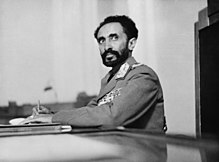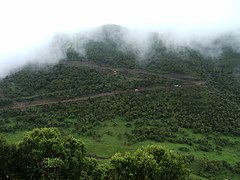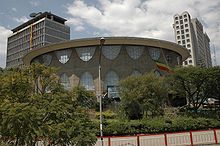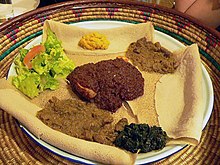Ethiopia
Ethiopia (in Amharic, ኢትዮጵያ, romanized: ītiyop'iya), officially the Federal Democratic Republic of Ethiopia (in Amharic, የኢትዮጵያ ፌዴራላዊ ዴሞክራሲያዊ ሪፐብሊ, romanized: ye'ītiyop'iya fēdēralawī dēmokirasīyawī rīpebilīki), formerly known as Abyssinia, is a landlocked country located in the Horn of Africa. Demographic estimates for 2021 place it as the second most populous country in Africa and the twelfth in the world. Its capital, as well as its largest city Large and populous, it is Addis Ababa. It is bordered to the north by Eritrea, to the northeast by Djibouti, to the east by Somalia, to the south by Kenya, and to the west by Sudan and South Sudan.
Ethiopia, where Christianity was early introduced, is the only case among African countries that has never been colonized, and maintained its independence during the Scramble for Africa, except for a period of five years (1936-1941), when it was under Italian occupation. With the independence of Eritrea in 1993 Ethiopia lost its landlock.
Ethiopia was a member of the League of Nations, signed the United Nations Declaration in 1942, founded the UN headquarters in Africa, was one of the original 51 members of the League, and is one of its founding members of the former Organization for African Unity and current African Union, during the government of negus Haile Selassie I.
Toponymy
The name «Ethiopia» is derived from the Greek Αἰθιοπία Æthiopia, which in turn comes from Αἰθίοψ Æthiops, 'Ethiopian', which in Greek would mean 'burnt-faced' (αιθ- burned, ὄψ face). However, ancient Ethiopian sources claim that the name derives from "'Ityopp'is" (who was the son of the Biblical Cush, brother of Nimrod, nephew of Mizraim, Fut, and Canaan, and great-grandson of Noah), legendary founder of the city of Axum.
Ethnonym
Abyssinians is the generic name given to the inhabitants of Ethiopia, especially to the inhabitants of the regions of Tigre, Amhara and the former province of Shoa. territories of Eritrea and Ethiopia. The ethnonym was losing strength for historical and ideological reasons before the Ethiopian term.
History
The mythical king of the Ethiopians, a people mentioned by Homer and located in Archaic Africa, south of Egypt, is Memnon (in ancient Greek Μέμνων / Memnôn, "he who stands firm&# 34;) who would have lived around 1250 a. C. For its part, the Ethiopian national legend indicates that its first king was Menelik, son of the queen of Sheba and King Solomon, who recounts the Old Testament (Kings, I, 10). Legend recorded in the XIV in an Ethiopian convent and dated to the VIII.
The port of Adulis will control the Red Sea trade from the III century BCE. C. by decision of Ptolemy Evergete. Fact considered as the embryo of the future Ethiopia. The maritime enclave allowed the enrichment of a local class of merchants and officials as well as the development of a powerful Sabeo-Ethiopian culture that would evolve to consolidate strong kingdoms. The first of these will be that of Axum, at the end of the century I d. This new state will channel all trade between the Mediterranean, the Red Sea and Asia. In the IV century, the Christianity. The powerful kingdom began to decline after the defeat of Mecca (570) against the Arabs. In 1270 the Solomonic dynasty was established, which gave rise to the Empire of Ethiopia. Between the centuries XV and XVI, the territory. In the 17th and 18th centuries" , the capital of the kingdom was moved to Gondar.
Ethiopia is the second oldest nation in the world to adopt Christianity as its official religion (AD 333) after Armenia (AD 301).
On January 21, 1872, Kassay the Tiger subjugated all the territory except Xoa, crowning himself in Aksum as negus and adopting the Christian name of John IV of Ethiopia. In 1884 the new The emperor made an agreement with the English admiral Newet that assured him free trade in Massaua, but when the Italians occupied this town, John IV showed a hostile attitude towards the new colonizers.
The Italian army suffered some losses at Dogali, but on March 9, 1890 Emperor John IV died at Metemmet. Due to the lack of coins in circulation during his reign, foreign coins were allowed to be used throughout the territory. To guarantee their circulation, these pieces were counter-marked with a circular punch containing the lion of Judah and its value. Different coins from Austria, France and Spain are known with this curious mark. Hassai's nephew Mangascha was dispossessed by Menelik II, who signed a pact with the Italians who had already occupied Karen and Asmara, territory that was recognized with the colony name of Eritrea.
During the European partition of Africa in the 19th century, Ethiopia retained its independence; however, in 1895 the Italian invasion occurred, from its colony in Eritrea. In 1931 Emperor Haile Selassie ascended the throne, whose coronation was attended by Plutarco Elías Calles. In 1935, the Italian troops of Benito Mussolini invaded the country. The Ethiopian army, which maintained cavalry with spears and a few with rifles, were no match for the Italian army. Mexican President Lázaro Cárdenas del Río sent arms to Ethiopia, but the Italians eventually conquered Ethiopia, and it was renamed Abyssinia. In 1936, the territory officially (with little international recognition) became part of Italian East Africa. During World War II, Italy's defeat at the Battle of Gondar restored power to Haile Selassie I. In 1952, the UN approved the federation of Ethiopia and Eritrea, later converted into a democratic country.
Haile Selassie made visits to Japan, where he was received by Emperor Hirohito, and Yugoslavia, where he was received by Marshal Tito. In 1966 he received French President Charles de Gaulle, because France had supported Ethiopia during the war.
By 1974, the Haile Selassie regime was facing widespread public discontent, exacerbated by military defeats at the hands of Eritrean guerrillas, and by severe famine in Wolo and Tigray provinces caused by drought. These events triggered a revolution led by low-ranking Army officers and promoted by left-wing political groups, which ended with the overthrow of the emperor. A military junta known as the Derg took over.
In 1977, he assumed control of the Derg Mengistu Haile Mariam, who established a socialist government. During this period the economy is socialized, aligned with the Soviet block. Between 1975 and 1985, children enrolled in primary education increased from about 957,300 to about 2,450,000. Although there were still variations between regions in the number of students enrolled and there was a disparity in the enrollment of boys and girls. However, while boys' enrollment had doubled, girls' enrollment had more than tripled in that period.
He suffers a terrible famine in 1984, due to a great drought, very common in the area like that of 1970. In 1991 the People's Democratic Republic of Ethiopia is overthrown in the middle of a civil war.
In May 1991, Meles Zenawi at the command of the Ethiopian People's Revolutionary Democratic Front achieved an armed victory over Menghistu and was proclaimed president, beginning a period of political and social reforms that led him to abandon the socialist regime. The new war with Eritrea from 1997 to 2000 ended with the independence of Eritrea and, under the patronage of the UN and the OAU, the final peace was obtained.
Government and politics
The operation of the Ethiopian institutions is governed by the constitutional text ratified in December 1994 and which came into force on August 22, 1995.
The parliamentary system instituted then rests on the Federal Parliamentary Assembly, made up of two chambers (bicameral) that represents the legislative power:
- the House of Popular Representatives: 547 members elected by direct universal suffrage every five years. It has competence in legislative, fiscal and budgetary matters.
- the Federation Chamber: composed of 153 members elected by indirect universal suffrage by representatives of the regions. It has the role of constitutional control essentially.
The executive branch has more powers. It is divided into two poles where the role is unequal:
- The President of the Republic is the head of State. It is chosen jointly by both chambers for a period of 6 years. Its functions are of an honorary and protocol nature, although it is recognized a certain power of influence.
- The prime minister manages the country policy. Choosed by the majority party in the House of Deputies, it is appointed for a five-year, renewable term once.
The judicial power rests with the federal Supreme Court, separated by the constitution from the legislative and executive powers. The constitution provides for a judiciary independent of the other powers. There is also a High Court and Courts of First Instance. Each regional state in turn has a parallel judicial system.
Human Rights
In terms of human rights, regarding membership of the seven bodies of the International Bill of Human Rights, which include the Human Rights Committee (HRC), Ethiopia has signed or ratified:
Territorial organization
Until 1995 Ethiopia was divided into thirteen provinces (fourteen before Eritrea's independence in 1993). Ethiopia currently has a tiered system of government, consisting of a federal government, regional states, zones, districts (woredas) and counties (kebele).[citation required]
Ethiopia is divided into ten regional states and two cities with special status:
|
|
*City with special status
Each of the regions has its own autonomous government, elected by its population, with quite extensive powers recognized by the Constitution itself, in addition to its own Parliament and Judiciary.
Geography
Following the independence of Eritrea, Ethiopia became a landlocked state, relying heavily on Djibouti for its maritime exports.
At 1,104,300 km², Ethiopia is the 27th largest country in the world. For comparative purposes, the extension of its territory is similar to that of Bolivia.
Most of Ethiopia lies in the Horn of Africa, which is the eastern tip of Africa. It borders Sudan and South Sudan to the west, Djibouti and Eritrea to the north, Somalia to the east, and Kenya to the south. The Great Rift Valley crosses the country from northeast to southwest, creating a depression zone that is the basin of several lakes.
The Ethiopian plateau to the west, the Harar massif to the east and the Somali plateau on the extreme eastern slope stand out as a whole. Ethiopia's hydrographic network includes the Blue Nile (1,450 km, including 800 in Ethiopia), Omo (760 km), Awash (1,200 km), Wabi Shabele (1,130 km) and Genale (480 km) rivers. The most important lake is the Tana, whose drainage forms the Blue Nile.
| Northwest: Sudan | North: Eritrea | Northeast: Djibouti |
| West: South Sudan |  | This: Somaliland |
| Southwest: Kenya | South: Kenya | Sureste: Somalia |
Ecology
The ecology of Ethiopia is fundamentally determined by altitude. In the low zones the savannahs predominate; WWF divides the Ethiopian savannahs into five ecoregions:
- Taste of Sahel acacias in the northwest
- East Sudanese savannah in the west
- Somali arbusive savannah in the center (Gran Valley of the Rift) and this
- Kenyan arbusive savannah in the southwest
- Mosaic of jungle and savannah of Lake Victoria basin, in an enclave of the southwest, on the border with Sudan.
Deserts are represented by Ethiopian xeric grassland and scrub, in the border region with Djibouti and southern Eritrea; and the Maasai xeric scrub and prairie, in the extreme southwest.
In the Ethiopian massif, the predominant biomes are the umbrophilous forest —Ethiopian montane forest, from 1,100 to 1,800 m above sea level— and the montane grassland, the latter represented by two ecoregions: the montane grassland and Ethiopian high bush, between 1,800 and 3,000 meters elevation, and the Ethiopian montane páramo above 3,000 meters.
To combat the endemic drought, the Government undertook an ambitious reforestation plan, called Green Legacy: in 2019, 353 million trees were planted in 12 hours, as part of a 4 billion planting campaign of trees to combat deforestation and climate change.
Economy
Ethiopia's economy is based on agriculture, which accounts for 45% of gross domestic product, 80% of exports and 20% of the workforce. The main product is coffee almost entirely destined for export, from which 25% of the population live directly or indirectly. This high volume, together with the variability of international coffee prices, make the export balance very vulnerable.
Drought processes, aggravated in the 1980s, turned large tracts of cultivated land into arid or semi-arid, partly due to climatic conditions, partly due to the felling of trees for firewood. The displacement of population and refugees on the occasion of the multiple wars with the separatist Eritrea, facilitated the settlement of large numbers of population in areas with few agricultural and livestock resources, which caused famines and persistent degradation of the soil that has not been recovered. At present, and after the signing of the definitive peace with Eritrea, the number of people dependent on internal or external aid for their survival has been reduced from 4.5 million people in 1999, to 2.7 million people in 2003.
In terms of mining, Ethiopia has reserves of gold and tantalum, as well as marble, potash, iron ore and natural gas. The farms of the latter have suffered various convulsions and ups and downs on the occasion of the multiple wars up to 2002.
The high level of dependence on the energy sector (oil) and the high military expenses still keep the economy weakened, which shows great changes depending on the area of the country in question. The tense relationship with Eritrea prevents the use of the Eritrean ports of Assab and Massawa, leaving that of Djibouti for the exit to the sea of Ethiopian products.
Currently, an economic plan is being developed based on the increase in the use of hydroelectric energy, the exploitation of natural gas, the recovery of agricultural areas and the diversification of economic activities, within an economy that is still highly centralized and dependent public sector and foreign aid.
In the period 2003-2005 the Ethiopian economy has grown by more than 10%, although the growth has been very uneven depending on the region. The perimeter of the capital has grown by 13% consecutively in the two years, the southern and western states have grown by an average of 8%, although the eastern states have grown less intensely and the northern regions have suffered a debacle of economic activity, due to geopolitical tensions with Sudan and Eritrea. The improvement in the export balance stands out, encouraged mainly by the increase in exports to Egypt.
Foreign aid accounts for more than 90% of the government budget. Only 2% of the country's population has access to mobile phones.
In October 2016, the new Addis Ababa-Djibouti railway was inaugurated. It is an international gauge electric railway linking Addis Ababa, the country's capital, with the port of Djibouti on the Gulf of Aden, providing rail access to the sea for Ethiopia. More than 95% of Ethiopia's trade passes through Djibouti, accounting for 70% of the activity in the Djibouti port. The new standard gauge railway replaces the old metric gauge Addis Ababa to Djibouti railway, which was abandoned in 2006 and was built by the French between 1894 and 1917.
Demographics
In 2015, Ethiopia had an estimated population of 90,320,987. Life expectancy is 65.01 years. The average number of children per woman is 4.3. An estimated 980,000 people (1.25% of the population) are infected with the human immunodeficiency virus. The urban population represents 17% of the total.
| Population developments (1500-2012) | ||
|---|---|---|
| Year | Population | Comments |
| 1500 | 2 000 | Estimated |
| 1800 | between 3 000 000 and 4 000 000 | Estimated |
| 1890 | 7,000 to 11 000 000 | Estimated |
| 1910 | 12 000 | Estimated |
| 1920 | 14 500 000 | Estimated |
| 1930 | 16 000 | Estimated |
| 1935 | 16 900 000 | Estimated |
| 1936 | 15,300 000 | (Italian invasion) |
| 1945 | 18 600 000 | Estimated |
| 1950 | 16,300 000 | Estimated |
| 1960 | 24 200 000 | Estimated |
| 1970 | 24 600 000 | estimated (hambruna from drought) |
| 1980 | 38 800 000 | Estimated |
| 1984 | 39 868 501 | Census (hambruna from drought) |
| 1994 | 53 477 265 | Census |
| 2000 | 62 564 875 | Census |
| 2007 | 73 918 505 | Census |
| 2015 | 90 320 987 | (based on 2007 census) |
| 2016 | 91 196 000 | Census |
Ethiopian ethnic groups
The main ethnic groups in Ethiopia are: Oromo, Amhara, Tigray, Sidama, Hadiya, Somali, Afar, Gurage, Gamo, Welaita and Argoba.
There are also different minority tribes, such as Surma, Mursi and Hamer.
Literacy
49.9% of the population is literate, corresponding to 55% of men and 45% of women. This reflects a reduction in literacy, compared to the 1980s.
Languages
Amharic, Sidamo, Tigrinya, Oromo, Gurage, Somali and Arabic are the most widely spoken languages, apart from other local languages. English is widely used as well, especially in business.
Amharic is the official working language in which all federal laws are published and is spoken by millions of Ethiopians as a second language. In February 2020, the Ethiopian government announced that four new languages would become Ethiopia's federal working languages: Afar, Oromo, Somali, and Tigrinya. According to the Ethiopian ambassador to the United States, the English was also now a working language of the Ethiopian government.
Religion
| Religion in Ethiopia (2020) |
|---|
| Christianity 61.9% Islam 35.9% Other religions 2.2% |
According to the 2007 national census, Christians (Orthodox, Protestant and Catholic) make up 65% of the country's population, Muslims 32% and traditional beliefs 3%. A part of Ethiopia believes in the Rastafarian and Haile Selassie I.
Often Christianity in Africa is thought of as a European import that came with colonialism, but this is not the case in Ethiopia. The Kingdom of Aksum was one of the first countries to officially adopt Christianity, when Saint Frumencius of Tire converted King Ezana during the IV< century. Many believe that the Gospel had entered Ethiopia even earlier, with the royal official described as having been baptized by Philip the Deacon in the Bible, in chapter 8 (vv. 26-39) of the Acts of the Apostles. Today, the Ethiopian Orthodox Church is by far the dominant one, although some Protestant churches have recently gained ground. The name "Ethiopia" (Hebrew Kush) is mentioned in the Bible several times, and is somewhat considered a sacred place.
Islam in Ethiopia has existed almost since the religion's founding: in the year 615, when a group of Muslims escaped persecution in Mecca on the advice of Muhammad and traveled to Ethiopia, which was ruled, according to the estimates of Muhammad, by a pious Christian king. Furthermore, Islamic tradition states that Bilal ibn Ribah. one of Muhammad's most prominent companions, was from Ethiopia.
Main Cities
In this list are the main Ethiopian cities according to the population estimates of the Ethiopian Central Statistical Agency, corresponding to 2008:
| Main Cities of Ethiopia (2008) | ||||
|---|---|---|---|---|
| Name | Region | In 1994 | In 2008 | |
| 1 | Abeba | City with special status | 2 300 000 | 3 941 452 |
| 2 | Dire Dawa | City with special status | 251 864 | 432 725 |
| 3 | Adama | Oromy | 127 842 | 279 317 |
| 4 | Gondar | Amhara | 112 249 | 209 471 |
| 5 | Mekele | Tigray | 96 938 | 190 473 |
| 6 | Dese | Amhara | 97 314 | 175 002 |
| 7 | Bahir Dar | Amhara | 96 140 | 174 925 |
| 8 | Jima | Oromy | 88 867 | 170 |
| 9 | Debre Zeyit | Oromy | 73 372 | 165 329 |
| 10 | Awasa | South Peoples Region | 69 169 | 159 748 |
Culture
Art
Gastronomy
Ethiopian cuisine consists of various starters and vegetable or meat dishes, usually a stew, served on top of injera, a thin long bread.
The injera is a kind of crêpe made with a cereal called teff or tef and that is grown in Ethiopia. After the dough is made, it is left to ferment and then it is thrown into a flat and round clay dish of about 40 cm in diameter, previously heated over a fire (usually wood), on top of which various meat or vegetable stews are poured and eaten by hand.
Traditional Ethiopian cuisine does not use pork of any kind, as Islam and the Ethiopian Orthodox Church forbid eating such meat.
Media
Few newspapers are published in Ethiopia. One of them is the Addis Tribune, published in Addis Ababa. Most of the population connects via ADSL implemented by the government, which maintains a strict monopoly, however the few corporations use satellite connections from foreign providers as active connection through Hispasat and NSS satellites.
Calendar
Ethiopia uses the Coptic Orthodox Church calendar, which is seven or eight years behind the Western calendar. Ethiopian New Year is celebrated on September 11. In the case of leap years, the holiday is the 12th; thus, September 12, 2007 was the first day of the new millennium for Ethiopia.
Coptic Ethiopians celebrate their year-end festival or Enkutatash "gift of jewels," based on an ancient legend, according to which the Queen of Sheba returned suddenly from her visit to King Solomon, in Jerusalem, being celebrated by its ministers and generals with great joy and filling the royal coffers with jewels. This celebration coincides with the Spring Festival in the southern hemisphere, and its festivities date back to that time.
Zero hour corresponds to six in the morning of international time.
Music, dance and singing
Some 1600 years before Europe, the Ethiopian saint Yared created a musical script for his repertoire of sacred music and dance. Ethiopian music, song and dance draw on the musical heritage of Yared. The most common folk dance, the Esskite, has fundamental traditional elements of the various peoples of the Ethiopian highlands. Characteristic of these dances is the rhythmic movement of the shoulders, with a pronounced mixture of religiosity, fetishism and sensuality defined by some observers as confusing and fascinating. In contrast to the dances of the highlands are the acrobatic dances of the Welaita and the theatrical gestures of the remote ethnic groups of Gamo-Gofa and the lower Omo Valley, who retain more traditional customs.
Due to its theme, the music of Ethiopia can be divided into three large groups: Ethiopian folk and traditional music, Coptic or sacred music, and popular music, which differs from folk music because of its more general nature and the foreign influences.
Among the influences of Ethiopian music are Rastafarian Nyahbinghi music and reggaeton, syncretic music of Jamaican origin, a mixture of different groups of African descent, with some diffusion in Ethiopia. Ethio-jazz, the brainchild of vibraphonist and music director Mulatu Astatke, is part of the history of Ethiopian music. Famous performers include vocalist Tilahun Gessesse and guitarist Bibisha.
Typical musical instruments include the krar, or five-stringed Ethiopian lyre, and the masenqo, a single-stringed violin and historical Ethiopian instrument. The esketa or "shoulder dance" is an Ethiopian dance. When moving with this dance it is as if the head and shoulders are working completely separate from the rest of the body. It is a significant part of the ancient tribal dances of Ethiopia.
It should be noted that the name of Etiopía has been used by foreign artists completely unrelated to Ethiopian music, as in the cases of the Argentine Nico Favio with the band Etiopía and the Basque writer Bernardo Atxaga in New music from Ethiopia.
Sports
Contenido relacionado
Evaristo
Jump
Epigraphy















